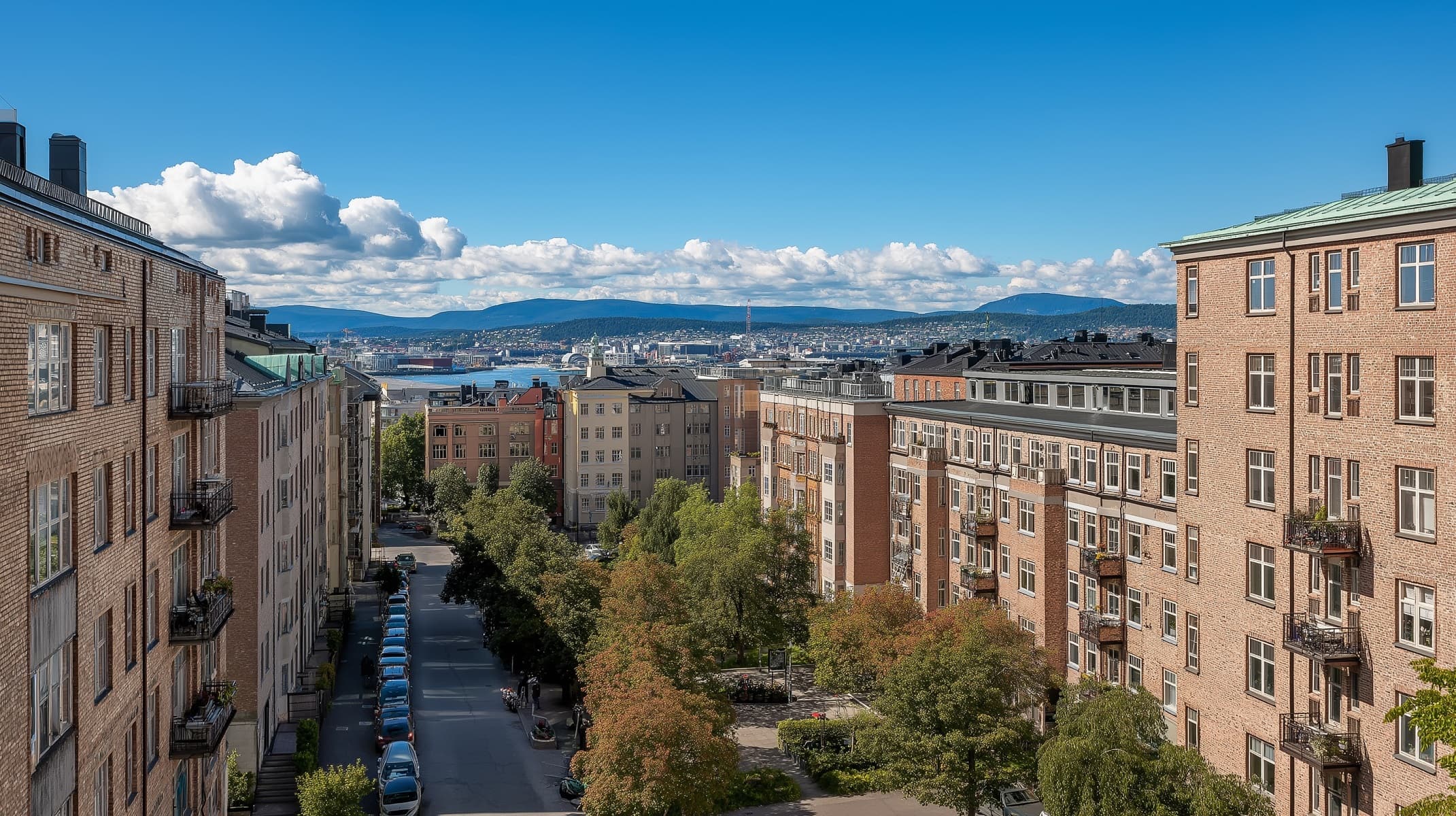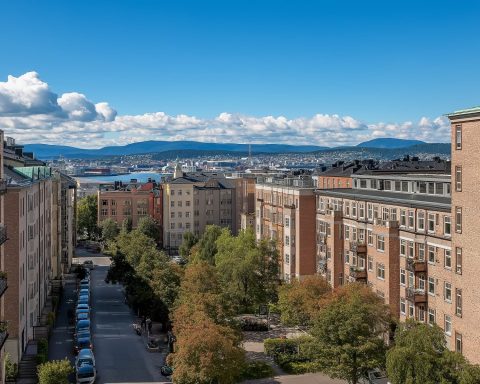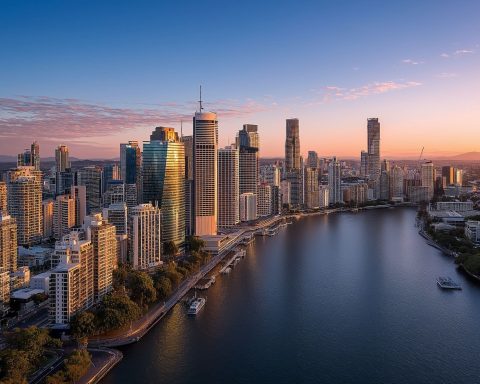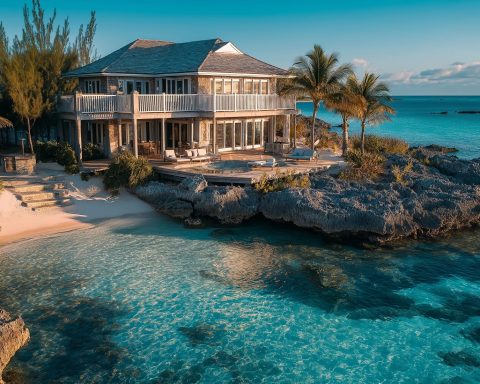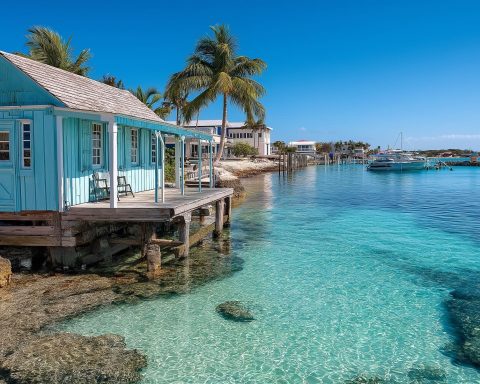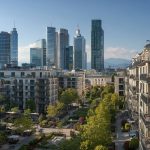Residential Property Market Trends in 2025
Oslo’s housing market is rebounding strongly in 2025 after a cooler period in late 2023. Home prices are rising again, albeit unevenly across Norway’s regions. Nationally, house prices climbed 2.4% year-on-year in Q1 2025, while Oslo (including neighboring Bærum) saw a 3.3% increase ssb.no. In fact, Oslo’s price growth has been somewhat weaker than expected – about +4.8% in the first five months of 2025, the lowest among major cities eiendomnorge.no. By contrast, oil-driven Stavanger surged with 8.4% annual growth ssb.no. Despite higher interest rates, buyer demand remains robust. So far in 2025, Norway has experienced record-breaking sales volumes in the second-hand housing market, with 15.6% more homes sold year-to-date than last year eiendomnorge.no. Oslo’s market benefits from underlying strong demand – homes are still selling quickly (national average 42 days on market in May, with even shorter times in popular areas) eiendomnorge.no. This resilience in demand, combined with limited supply, is driving a seller’s market in Oslo’s residential sector.
Table: House Price Growth in Oslo vs. Other Cities (Seasonally Adjusted, Q1 2024–Q1 2025)
| Region | House Price Change YOY Q1 2025 |
|---|---|
| Oslo (incl. Bærum) | +3.3% ssb.no |
| Stavanger | +8.4% ssb.no |
| Bergen | +3.5% ssb.no |
| Trondheim | +0.9% ssb.no |
| Norway (overall) | +2.4% ssb.no |
Despite moderate price growth in Oslo so far, industry experts foresee acceleration. Economists predict a rebound in Oslo’s housing prices through 2025, citing Oslo as a key driver of a national upswing bt.no. The chief economist of Eiendom Norge noted that house prices could rise over 10% in Oslo in 2025, buoyed by chronic housing shortages, expected interest rate cuts, and solid wage growth lister24.no lister24.no. In the first quarter alone, Oslo’s house prices jumped 8.4% from the previous quarter, seasonally adjusted ssb.no, indicating strong momentum into spring. By mid-2025, the average Norwegian home costs NOK 5.11 million, up from NOK 4.87 million just a month prior investropa.com. Oslo remains the priciest market – a standard 2-bedroom apartment in the capital often exceeds NOK 7 million (roughly €8,300 per m²) investropa.com investropa.com. Such high prices underscore both Oslo’s desirability and its affordability challenges. Overall, the residential trend in 2025 is one of renewed growth: after a flat end to 2023, Oslo’s home values are climbing again, supported by fierce demand and limited supply.
Commercial Property Market Trends
Oslo’s commercial real estate sector is navigating a turning point in 2025. After two years of headwinds, a “new upcycle” is beginning as the economy stabilizes cbre.com. Office properties saw a strong investment rebound in 2024, led by well-capitalized buyers. Prime office yields actually compressed slightly as equity-rich investors snapped up quality assets 7049971.fs1.hubspotusercontent-na1.net. Office rents in Oslo rose about 4% in 2024, but growth leveled off by mid-2025 7049971.fs1.hubspotusercontent-na1.net. Rental demand has cooled somewhat in Oslo’s office market, and it’s taking longer to lease space, especially in older buildings 7049971.fs1.hubspotusercontent-na1.net 7049971.fs1.hubspotusercontent-na1.net. New landmark projects like Oslo Science City (34,000 m²) and the Life Science Building at the University of Oslo (97,000 m²), due by 2026, will add significant modern office supply 7049971.fs1.hubspotusercontent-na1.net. These few large projects account for nearly 88% of expected new office supply in Oslo through 2026 7049971.fs1.hubspotusercontent-na1.net, meaning beyond them, construction is subdued. Office vacancy has ticked up from historically low levels, but prime rents remain flat and Grade A rents even dipped slightly in early 2025 as tenants gain negotiating power 7049971.fs1.hubspotusercontent-na1.net. Still, well-located, energy-efficient offices in Oslo’s core hold their value, whereas older, non-sustainable buildings face pricing and refinancing challenges.
In retail real estate, a turning point is also evident. Consumer spending is set to improve as inflation eases and interest rates stabilize, which should lift retail sales in 2025 cbre.com. Investors are focusing on necessity-based retail (like grocery-anchored centers) as safer bets cbre.com. High-street retail in Oslo’s downtown remains robust at the luxury end – Nedre Slottsgate now boasts the densest concentration of luxury retailers on a single street in Europe 7049971.fs1.hubspotusercontent-na1.net. Meanwhile, industrial and logistics properties continue to see strong demand. Logistics leasing picked up in late 2024 and is expected to stay buoyant in 2025 cbre.com. Vacancy in warehouses may rise slightly from near-zero levels, but new big-box developments around Oslo are attracting tenants quickly cbre.com. Hotel properties are another bright spot: Oslo’s hospitality sector has recovered strongly from the pandemic, with RevPAR (revenue per available room) in Oslo up 6.3% year-on-year and now over 32% higher than 2019 levels 7049971.fs1.hubspotusercontent-na1.net. International tourism is surging, sustaining high occupancy, though Oslo’s hotel occupancy is still just shy of pre-pandemic rates 7049971.fs1.hubspotusercontent-na1.net. Overall, commercial real estate investors are cautiously optimistic – 2024 saw a 45% jump in investment volumes in Norway 7049971.fs1.hubspotusercontent-na1.net – but they remain selective. Refinancing pressures are a key trend: higher interest costs have created a “debt gap,” forcing some highly leveraged owners to sell properties. This notable presence of forced sellers, due to refinancing challenges, is expected to continue into 2025 as loans reprice at higher rates and property values have softened 7049971.fs1.hubspotusercontent-na1.net. In sum, Oslo’s commercial property market in 2025 is characterized by stabilization and selective strength: prime assets (offices, necessity retail, logistics, hotels) are rebounding, while secondary assets and developers with weak finances face headwinds.
Housing Price Developments and Forecasts
After a mild correction in late 2023, Oslo’s housing prices are climbing again and forecasts point to a significant surge. In 2024, Norway’s nationwide house price index rose a modest 6.4% investropa.com, but momentum accelerated into 2025. Through mid-2025, prices are about 5.9–7.3% higher year-on-year investropa.com investropa.com, one of the strongest growth periods in recent years. This is remarkable given that Norges Bank’s policy rate sits at its highest since 2008 (4.50%) and mortgage rates around 5.6% investropa.com investropa.com. High borrowing costs have not prevented a “rapid recovery” in housing prices – in fact, the central bank has flagged the housing rebound as a concern for affordability livingimpact.no. Oslo’s own price growth, while initially lagging, is expected to outpace the national average by year-end. Eiendom Norge (the Realtors’ Association) released a bullish 2025 forecast of +10% house price growth nationally, and predicted Oslo, along with Bergen and Stavanger, would rise even more than 10% lister24.no lister24.no. This forecast measures December 2024 to December 2025, meaning a double-digit jump in prices over the calendar year lister24.no. The rationale: an unprecedented shortage of new homes, strong income growth, and likely interest rate cuts will create a perfect recipe for price acceleration lister24.no.
Indeed, interest rates are expected to pivot downward. Norges Bank signaled a probable rate cut in March 2025, with perhaps two more later in the year lister24.no. Lower rates will boost buyers’ purchasing power and could unleash pent-up demand, fueling further price growth lister24.no lister24.no. Meanwhile, households’ financial health is relatively solid – unemployment is low and wages are rising, so many buyers are absorbing the higher mortgage costs. Analysts note that Norway’s housing market has been “less interest-sensitive” than expected, with prices holding high despite rate hikes bt.no. Some even argue we are entering a “new normal” of sustained higher rates without a crash in house prices bt.no bt.no. However, the affordability crunch is real: Oslo’s Nurse Index (“Sykepleierindeksen”) shows that in 2024 a nurse could afford only 2.3% of homes for sale in Oslo – down from 2.7% the year before, and projected to drop below 2% in 2025 livingimpact.no. In other words, price growth is far outpacing local income growth, pushing first-time buyers to the brink. Industry voices warn that double-digit price inflation in 2025 could deepen an affordability crisis, with ever-fewer units within reach of average earners livingimpact.no. Overall, the near-term outlook is strong price growth – perhaps uncomfortably strong. Expert opinions converge that unless supply improves markedly, Oslo’s housing values will keep rising in the coming years, barring an external economic shock. By 2030, some forecasts even point to cumulative gains that could put Oslo’s home values 30% higher than today livingimpact.no. The challenge ahead will be managing this growth to avoid overheating and a larger affordability gap.
Supply and Demand Dynamics
Oslo’s real estate market is defined by a fundamental mismatch between demand and supply. Demand for housing in the capital has never been higher: 2025 is on track for the most second-hand home sales ever recorded in Norway eiendomnorge.no. Buyer activity surged in early 2025, with homes selling faster and in greater numbers than last year eiendomnorge.no eiendomnorge.no. Yet this vibrant demand faces a growing supply crunch. New housing construction has plummeted to crisis levels, meaning fewer homes are coming on the market. Not since the 2008 financial crisis have so few homes been built in Norway nbbl.no. In Oslo, housing developers have largely hit the brakes. Completions of new homes in Oslo dropped to roughly 1,567 units in 2024, barely half of the city’s estimated annual need estatenyheter.no estatenyheter.no. Worse, the pipeline is drying up: due to weak new sales and soaring construction costs, almost no new projects are being started. Eiendom Norge’s CEO Henning Lauridsen reports that in Q3 2023 only 10 new homes were started in Oslo – essentially a standstill eiendomswatch.no. Nationwide, housing starts might total just ~12,000 in 2023, against a demographic need for nearly 30,000 units eiendomswatch.no. This gap foreshadows a severe undersupply. Lauridsen bluntly warns, “It is a crisis”, noting that homes not initiated in 2023 will result in a shortfall hitting the market fully in 2025–2026 eiendomswatch.no. By 2027, if 2024’s building slump continues, Oslo could see housing completions nearly 90% below the 2023 peak livingimpact.no – an alarming scenario where new supply almost evaporates.
This supply crunch collides with steady demand drivers. Oslo’s population continues to grow (the municipality reached ~720,000 residents in 2024 lifeinnorway.net), and immigration is adding thousands of new residents. Even as Norway’s overall population growth is modest, urban areas like Oslo are absorbing most of it livingimpact.no. Young professionals and immigrants in particular fuel strong demand for starter apartments and rentals, keeping the market competitive livingimpact.no. Household formation remains robust – despite very high prices, Norwegians strongly favor home ownership, aided by historically low unemployment and social safety nets. On the demand side, another factor is investment interest: both domestic and foreign investors are drawn to Oslo real estate as a stable asset (more on that below). Thus, demand has a firm floor under it, even in a high-rate environment. On the supply side, however, there is a structural bottleneck. Years of slow regulatory processing and opposition to density have constrained building. The average permitting time for new housing plans in Oslo is 5–6 years, more than double what it was in 2016 nbbl.no. This means even when market conditions improve, supply cannot react quickly – “housing construction is like a tanker, it takes a long time to turn,” Lauridsen notes lister24.no. The result is that too many buyers will be chasing too few homes, which almost inevitably sparks bidding wars and price jumps in desirable areas nbbl.no nbbl.no. We are already seeing early signs: in May 2025, the number of homes listed grew faster than sales, leading to a larger inventory entering the summer eiendomnorge.no. However, peak season demand is expected to “drain away” much of that supply by mid-summer eiendomnorge.no. In short, market activity is high but inventory remains tight. Unless construction picks up dramatically, the imbalance between roaring demand and meager supply will persist, underpinning the market’s upward trajectory – but also heightening the risk of a squeeze where only the wealthy can afford Oslo’s housing.
Popular and Emerging Neighborhoods
Oslo’s real estate landscape is not monolithic – neighborhood trends vary, with some districts booming thanks to new developments and infrastructure. Traditional upscale areas like Frogner, Majorstuen, and Tjuvholmen remain perennially popular for their central location and amenities. But recently, attention has turned to a number of up-and-coming neighborhoods poised for growth:
- Nydalen: Once an industrial area, Nydalen has transformed into a dynamic business and education hub. The expansion of BI Norwegian Business School’s campus (now hosting ~10–12,000 students and staff) has injected huge rental demand and life into Nydalen investropa.com. New mixed-use projects (e.g. the Vertikal Nydalen tower) add modern apartments, offices, and restaurants, creating a vibrant community investropa.com. With a refurbished metro station and excellent transit, Nydalen’s connectivity has improved, making it one of Oslo’s hottest investment areas in 2025. Property prices here have surged since 2023 in response to the revitalization investropa.com.
- Løren: Located in Oslo’s northeast, Løren is experiencing a construction boom and fast-improving infrastructure. Major residential projects – like Veidekke’s Lille Løren Park (355 eco-friendly apartments plus a kindergarten) due by end-2025, and the Løren Botaniske development (385 sustainable apartments) – are adding much-needed housing stock investropa.com. Public transport upgrades under the “Oslo Package 3” initiative have delivered a new Løren metro station and better connectivity investropa.com. These improvements make Løren highly attractive to young families, who enjoy new parks, schools, and amenities in the area investropa.com. With Oslo’s overall housing shortage, Løren’s surge of modern, green housing (and strong media buzz about it) has positioned the neighborhood as a rising star for both homebuyers and investors.
- St. Hanshaugen: An established central neighborhood that’s becoming even more desirable, St. Hanshaugen combines lush green spaces with urban perks. The area has one of Oslo’s highest concentrations of parks, with 98% of residents living within 300 meters of a green area investropa.com. This access to nature, alongside a trendy café and cultural scene, is drawing young professionals and families. Property values are climbing (prices rose ~6% in 2024 here, with further growth expected) investropa.com. New cultural and commercial projects are also boosting appeal investropa.com. St. Hanshaugen’s blend of tranquil parks and city life is driving up demand and making it a hotspot for 2025.
- Sørenga (Bjørvika Waterfront): Sørenga, part of the Fjord City redevelopment, has evolved from a former container port into a thriving waterfront residential quarter. Modern apartment complexes, many with fjord views, and attractions like the Sørenga seawater pool and urban beach have made it hugely popular investropa.com. High demand has led to very high occupancy and price growth in Sørenga’s housing developments investropa.com. The broader Fjordbyen (Fjord City) vision continues to invest in new amenities, recreational facilities, and infrastructure along Oslo’s harbor investropa.com, further cementing Sørenga/Bjørvika as a premier location. With cultural landmarks like the Oslo Opera House and the new Munch Museum next door, Bjørvika’s luxury apartments command top prices and saw substantial appreciation in 2024 investropa.com investropa.com. This area exemplifies the modern, high-end living that’s increasingly in demand.
- Lilleaker / Fornebu Corridor: In the western suburbs, Lilleaker is gaining attention for offering suburban charm with city access. The extension of the tram line and the upcoming Fornebubanen metro (expected by 2029) will directly link this area to central Oslo, vastly improving connectivity investropa.com. The Lilleakerbyen redevelopment is underway, bringing new housing, shops, and parks and creating a “town within a town” ideal for families investropa.com. Because of these factors, Lilleaker/Fornebu is turning into a family-friendly favorite – a place where one can enjoy quieter living and green space without sacrificing an easy commute. As the Fornebubanen project progresses, property values along its route are projected to rise, anticipating the convenience the new line will bring investropa.com.
- Bjørvika – Barcode & Opera Quarter: Already famous for its striking skyline of “Barcode” high-rises, Bjørvika continues to boom with new luxury residential towers. As noted, this waterfront district saw some of the steepest price increases recently investropa.com. Its mix of cutting-edge architecture, cultural venues (Opera House, museums), and proximity to the central business district make it a magnet for affluent buyers. Excellent transit and pedestrian infrastructure keep occupancy rates high, and media praise for its modern urban design has attracted international attention investropa.com. Bjørvika exemplifies Oslo’s transformation into a modern metropolis, with property values to match its prestige.
- Ekeberg: On the hills southeast of downtown, Ekeberg offers something unique – sweeping panoramic views of Oslo fjord and city skyline. This scenic allure, plus the adjacent Ekebergparken sculpture park and abundant nature trails, has made Ekeberg highly sought by those craving nature at their doorstep investropa.com investropa.com. In recent years, home prices in Ekeberg have been climbing steadily, and the trend is expected to continue as more buyers prioritize lifestyle and green surroundings investropa.com. Properties here, especially ones with unobstructed views, are attracting a premium from nature enthusiasts. The continued enhancement of Ekebergparken (with new art installations and facilities) further boosts the area’s appeal investropa.com. Ekeberg is becoming a preferred enclave for those who want tranquility without leaving the city – a prime investment for view properties.
- Ensjø: A former industrial zone in eastern Oslo, Ensjø is in the midst of a long-term redevelopment into a residential hub often called the “New Ensjø City”. Multiple new condo projects and infrastructure upgrades (roads, bike paths) are transforming Ensjø into a modern urban neighborhood. The housing market here benefited from a pause in Oslo’s price growth during 2023–24 – effectively a stabilization period that set the stage for future gains investropa.com. With Norway’s house prices expected to rise ~5% in 2025 investropa.com, areas like Ensjø are positioned for a favorable outlook. Additionally, broader transport plans under the National Transport Plan 2022–2033 will improve connectivity citywide (e.g., new rail links and highways) and Ensjø stands to gain indirectly from these sustainable mobility initiatives investropa.com. Ensjø’s appeal is also tied to Oslo’s startup and tech growth – being part of the wider Oslo innovation region means economic prospects for the area are good investropa.com. Investors note that modern flats in Ensjø offer better value and future upside compared to the saturated inner-city, making it a promising area for long-term growth.
In summary, Oslo’s neighborhood trends reflect both revitalization and expansion. Emerging districts like Nydalen, Løren, and Ensjø highlight where new housing supply (albeit limited) is concentrated and where infrastructure upgrades are creating investment opportunities. Meanwhile, established central areas and scenic spots like St. Hanshaugen and Ekeberg continue to appreciate, driven by lifestyle appeal. For real estate buyers in 2025, understanding these local dynamics – which areas are “hot” and why – is crucial. The best opportunities often lie in neighborhoods with new transport links or major development projects, as they tend to experience outsized growth in demand and property values.
Economic and Demographic Influences
Broader economic and demographic trends in Norway set the context for Oslo’s property market. Macroeconomic conditions in 2025 are improving: after a challenging couple of years with high inflation and rate hikes, the Norwegian economy is expected to recover with easing inflation and stabilizing interest rates cbre.com. Inflation cooled to about 2.2% in 2024 cbre.com, and with central bank tightening likely peaked, real disposable incomes are rising again. Norway’s Mainland GDP growth was modest (~0.9% in 2024) cbre.com, but is projected to pick up slightly above trend in coming years as global conditions improve nho.no. Crucially for housing, interest rates are at or near their peak. The policy rate of 4.5% has been held steady since late 2023, and as noted, markets anticipate rate cuts from spring 2025 lister24.no. This means the era of continually rising mortgage rates is ending, relieving some pressure on borrowers. Already, fixed mortgage rates have stabilized around ~5.65% investropa.com and might edge down if the central bank starts easing. Lower financing costs in late 2025 and 2026 would bolster housing affordability and potentially expand credit availability – a positive for real estate demand.
On the demographic side, Oslo continues to be Norway’s primary magnet for people and jobs. While Norway’s overall population growth is moderate (projected +10% from 2024 to 2050) ssb.no, urban centers are growing faster. Oslo’s population reached 717,000 in Jan 2024 en.wikipedia.org and has grown by over 23,000 in the last four years lifeinnorway.net. International immigration is a key contributor; Norway saw a net population increase of 19,500 in just Q3 2023 eiendomswatch.no, much of that likely in cities. Oslo also experiences internal migration, especially of young adults, although in recent years high housing costs have pushed some to surrounding municipalities. Demographically, Norway faces aging and low birth rates (a common trend in Europe) livingimpact.no. However, Oslo’s housing demand is bolstered by younger households and immigrants. The city’s population is younger on average than the rest of the country and many young professionals prefer living centrally. Additionally, smaller household sizes (many singles) mean more housing units are needed per capita over time. These demographic shifts – aging, urbanization, smaller households – are altering housing demand profiles livingimpact.no. For example, there’s growing need for smaller apartments for singles and seniors, as well as continued high demand for family-sized homes due to sustained immigration.
Another influence is the labor market and income growth. Norway’s labor market remains robust; unemployment in Oslo is low (hovering around 3–4%). The country also saw strong wage growth through 2023–2024, partly as workers demanded raises to keep up with inflation. Solid wage increases (and generous social benefits) have kept household finances relatively healthy, enabling many to cope with higher mortgage payments. This strong purchasing power supports the housing market – indeed, wage growth was cited as one factor allowing house prices to rise in 2025 despite high rates investropa.com lister24.no. That said, affordability is stretched: the ratio of home prices to incomes in Oslo is at record highs. The rental market provides another lens on economic influence. With many priced out of buying, rental demand is surging. Rents in Oslo have jumped ~30.8% since 2019, and the median rent for a one-bedroom is now around NOK 10,000 per month livingimpact.no. High rents indicate a tight housing market and also affect labor mobility (e.g. key workers like nurses find both buying and renting challenging, as noted by the Nurse Index).
Lastly, Norway’s policy environment and social stability – low corruption, strong rule of law, sizeable sovereign wealth fund – create a backdrop of economic confidence that attracts foreign investors and keeps domestic consumer confidence fairly high. Consumer sentiment surveys (e.g. Finans Norge’s expectation barometer) have been subdued due to high interest rates, with many Norwegians saying it’s “not the time for major purchases” finansavisen.no. However, this sentiment is shifting as rate hikes pause and the public sees light at the end of the tunnel. Overall, economic and demographic factors in 2025 provide a mixed but mostly supportive picture for Oslo real estate: rising incomes and population underpin demand, while the promise of monetary easing improves the outlook. The main challenge remains aligning housing supply with these growth dynamics in a sustainable way.
Infrastructure Developments Impacting Real Estate
Major infrastructure and development projects are reshaping parts of Oslo and can significantly impact real estate values. Perhaps the most anticipated is the Fornebubanen – a new 8 km subway line that will connect Oslo’s metro network to Fornebu (a burgeoning tech/business district and residential area west of the city). This NOK 26 billion project is underway and, once completed (estimated around 2029), will cut travel times from Fornebu/Lysaker to downtown to under 15 minutes. Areas along the route, such as Skøyen, Vækerø, and Lilleaker, are already seeing increased investor interest in anticipation of the connectivity boost. As noted, Lilleaker’s family-friendly appeal is enhanced by the coming line investropa.com. Historically, new rail lines in Oslo (like the Løren Line opened in 2016) have lifted property prices in surrounding neighborhoods, and Fornebubanen is expected to do the same – bringing a price premium to formerly less accessible areas.
Another transformative plan is Oslo’s continuing Fjord City (Fjordbyen) development. This multi-decade project redevelops the waterfront from west to east. We’ve seen spectacular results in Bjørvika (new museums, offices, and thousands of apartments) and Tjuvholmen. Further west, attention is turning to redeveloping the Filipstad pier area and upgrading port infrastructure. As the port’s cargo operations gradually relocate out of downtown, valuable seaside land will open for mixed-use projects. The city’s aim is more housing, parks, and commercial space along the fjord. The continued investment in waterfront infrastructure – new promenades, cycling paths, marinas, etc. – not only elevates quality of life but also drives up the desirability of nearby real estate investropa.com. For example, the extension of the Havnepromenaden (harbor promenade) and new footbridges have knitted neighborhoods together and boosted property demand in formerly industrial spots like Sørenga and Lohavn.
Transport infrastructure improvements beyond Fornebubanen also play a role. The National Transport Plan 2022–2033 allocates large investments in roads and rail that benefit the Oslo region investropa.com. A notable project is the new Follo Line railway, which opened in late 2022, halving train travel time between Oslo and the growing town of Ski. This makes commuting from the southern suburbs more feasible and has ripple effects on housing markets there (people may opt to live further out, easing Oslo’s pressure somewhat). Additionally, highway upgrades such as the E18 West Corridor modernization (including tunneling parts of the highway and improving interchanges around Sandvika) will reduce congestion and noise, potentially unlocking new development parcels and improving suburban property values. Within the city, Oslo is investing in public transit upgrades: new tram lines and extensions (the tram network is expanding to areas like Tonsenhagen by 2027), purchase of higher-capacity trams and buses, and bike lane expansions. These efforts align with Oslo’s goal to be the world’s first emissions-free city by 2030 investropa.com and improve the livability of neighborhoods, which often correlates with higher real estate demand. For instance, the Løren area’s surge is partly due to the new Løren metro station from a few years ago investropa.com. Future metro expansions being planned – like an extension to Ahus hospital in Lørenskog – could similarly uplift the eastern corridor’s real estate in coming years.
Major civic developments also impact the market. The Norwegian government (through Statsbygg) is undertaking the New Government Quarter project in central Oslo. This will consolidate and rebuild government offices on the site of the ones destroyed in 2011, including new high-rise buildings and public spaces. Construction began in 2021 and will continue through much of the decade. When completed, it will bring thousands of jobs back into the city center daily, benefiting downtown retailers and potentially increasing demand for nearby housing (e.g. in Grünerløkka, St. Hanshaugen). Likewise, other Statsbygg-led projects like the expansion of the National Museum (opened 2022) or the upcoming Viking Age Museum at Bygdøy (reopening in 2026) enhance Oslo’s cultural infrastructure and can make surrounding districts more attractive for living.
Infrastructure can also influence commercial real estate. The advent of 5G networks and data centers in the region (attracted by Norway’s cheap renewable energy) makes Oslo a potential tech hub, increasing demand for modern office space. For example, a huge new data center campus (Skygard in Oslo region) coming online in 2025 signals growth in that sector 7049971.fs1.hubspotusercontent-na1.net. Additionally, ongoing upgrades to Oslo Airport (widening capacity) and green mobility initiatives (like an electric ferry network in the Oslofjord) will over time facilitate business and tourism growth, indirectly bolstering the real estate sector.
In summary, infrastructure development is a key enabler of Oslo’s real estate growth. New transport links, in particular, tend to raise property values and spur development in connected areas. The city’s push for sustainable urban improvement (transit, green spaces, cultural sites) is making more neighborhoods attractive and accessible. Investors closely watch these projects – being ahead of an infrastructure upgrade can mean getting into a neighborhood before property values fully reflect the positive change. Thus in 2025 and the coming years, places like the Fornebu-Lilleaker corridor, continued Fjord City sites, and transit-oriented districts stand out as ones to watch.
Regulatory Changes and Government Policy Updates
Recent and proposed policy changes are aiming to address the housing market’s challenges, though with mixed reception. One hot topic is Norway’s mortgage lending regulation (Utlånsforskriften), which caps loan-to-income ratios and requires high down payments for second homes (40% in Oslo). This regulation was designed to prevent excessive debt and speculation, but with the market cooling in 2023, some industry leaders argue it’s now hampering first-time buyers and new development. Eiendom Norge has called for abolishing or easing the lending regulation, calling it “redundant” given new financial contracts law and the current market situation eiendomswatch.no. However, the Financial Supervisory Authority and Finans Norge (the finance industry association) are cautious – they credit the rules with strengthening household balance sheets. As of early 2025, the government has not removed these rules, but there is pressure to consider adjustments if housing supply and first-buyer access worsen eiendomswatch.no. We may see higher flexibility quotas for banks or special terms for newbuild purchases as possible tweaks.
Another significant local policy issue is Oslo’s Småhusplan (Small House Plan), a regulation governing low-density residential zones. In mid-2023, after years of debate, the city council agreed on a new Småhusplan that slightly relaxes some restrictions to encourage more housing units on large residential lots. For example, the revised plan allows four-unit townhouses (fourmannsboliger) even in what were single-home zones, and lowers the minimum lot area for multi-unit buildings to 400 m² raederbing.no. It also raises permitted building heights marginally and reduces required private outdoor area per unit to 100 m² (down from 150) to enable more dense use of land raederbing.no raederbing.no. These changes were meant to strike a balance: enable more homes (to fight the shortage) while maintaining some greenery and character in villa neighborhoods. However, the new plan hit a snag – Norway’s water and energy directorate (NVE) protested that landslide/flood risk assessments in these zones were insufficient oslo.kommune.no aftenposten.no. As a result, the plan has not taken legal effect yet and a temporary freeze on construction in small-house zones remains in some areas. With a new city government (a more pro-development coalition elected in late 2023), there’s a push to resolve this. Policymakers from both major parties indicated they want to increase the housing construction pace in Oslo arkitektur.no, which likely means getting a workable Småhusplan in place. If the plan proceeds, it could unlock modest densification – e.g. splitting large lots or replacing single houses with duplexes or four-flats – contributing to housing supply over time. For homeowners and investors, that could mean more redevelopment opportunities in Oslo’s outer districts, but also potential impacts on neighborhood aesthetics and land values.
Nationally, the government has shown concern about the looming housing shortfall. A working group under the Ministry of Local Government (KDD) set an ambitious goal to build 130,000 new homes by 2030 and in June 2025 delivered 73 proposals to achieve it eiendomnorge.no. Many proposals focus on simplifying planning and construction processes – cutting red tape, faster zoning, standardizing building codes – essentially to “speed up the tanker.” Eiendom Norge’s view is that while simplification helps, the real issue is political will at the municipal level eiendomnorge.no eiendomnorge.no. Municipal finances are strained (many have high debt and rising interest expenses), and there’s fear that local governments might actually de-prioritize new housing projects that require costly infrastructure eiendomnorge.no. To counter this, some unorthodox policy ideas have emerged. In late 2023, Henning Lauridsen (Eiendom Norge) suggested “emergency” measures such as municipal purchase programs for unsold new homes, tax incentives like lower wealth tax on secondary rental homes, and shifting government subsidies from electric cars to housing support eiendomswatch.no. These ideas reflect mounting alarm over the construction slump. While the national government hasn’t enacted such steps yet, 2024’s state budget did include funding for more student housing and some subsidies for first-time buyers in rural areas. If the crisis deepens, we could see Oslo or the state consider buying new units to keep builders afloat, or loosening tax/loan constraints to stimulate activity eiendomswatch.no.
Another regulatory update affecting the rental market is the new Tenancy Act amendments (though relatively minor) and ongoing discussions about rent control. Norway doesn’t have strict rent caps, but landlords can only raise rent of ongoing leases by about CPI once a year. With rents soaring ~30% in a few years, tenant groups are lobbying for stronger protections. So far, the government response has been cautious, focusing instead on increasing housing supply (including more public and nonprofit housing). Also notable is property tax: Oslo imposes an annual property tax (currently 3‰ of value above a free allowance). The incoming city council in 2023 campaigned on reducing property tax, which they began to do in 2024 by raising the exemption threshold. If fully eliminated, it could slightly improve housing affordability at the margin, though it would also remove a revenue source used for services.
In summary, policy changes in 2025 are aimed at easing the housing shortage and maintaining financial stability, but progress is slow. Easing credit rules or speeding up planning could help supply, yet those are longer-term remedies. In the near term, the government’s clearest impact will be through interest rate policy (via Norges Bank) – the expected rate cuts are effectively a policy loosening that will buoy the market lister24.no. Regulatory risks also bear watching: if home prices spiral too high, political pressure could mount for buyer-side cooling measures (as seen in some countries). Conversely, if construction remains moribund, authorities may get more aggressive in incentivizing development. For now, the regulatory environment is in a cautious balancing act – trying to nudge more housing development without undermining prudential safeguards or local autonomy.
Investment Opportunities and Risks
Given the above trends, Oslo’s real estate market in 2025 presents a mix of attractive opportunities and notable risks for investors. On the opportunity side, rental yields are improving after years of being low. Central Oslo apartments historically had modest yields (~3% gross), but as rents climb faster than prices, yields have ticked up. It’s expected that city-center rental yields will rise with continued strong tenant demand investropa.com. An analysis finds the average gross yield on Oslo apartments is around 3.2%, and newer properties (e.g. large modern flats) can yield ~3.7% investropa.com. In a low-interest environment, those yields were meager, but with interest rates at 4-5%, a ~3.5% rental yield starts to look reasonable – especially if rate cuts bring borrowing costs down. Investors able to buy with equity or low-cost financing see Oslo’s tight rental market as a relatively safe bet: vacancy is extremely low and rent defaults are rare due to Norway’s social safety nets. Furthermore, the weaker Norwegian krone has made Oslo properties cheaper in foreign currency terms. The krone depreciated ~6.5% in 2022 and another 1.3% in 2023 investropa.com, so international buyers now find better value. For example, at current exchange rates, prime Oslo apartments cost significantly less per square meter than those in other Nordic or Western European capitals – about €8,300/m² in Oslo versus well over €10,000 in Stockholm or Copenhagen’s prime areas investropa.com. This currency discount, combined with Norway’s stability, is drawing more foreign investors to Oslo’s property market investropa.com investropa.com. Oslo is increasingly seen as a “safe haven” real estate market with stable long-term growth and strong rule of law. Cross-border investment in Norwegian property averaged 18% of volume in recent years and could rise again investropa.com. International funds appreciate Norway’s high transparency and the backing of its trillion-dollar sovereign wealth fund (which underpins economic stability) investropa.com.
Another opportunity lies in distressed assets and value-add projects. With the financing strain mentioned earlier, some developers and landlords under pressure may sell assets at a discount. Investors with liquidity can pick up quality buildings from “motivated sellers” who need to refinance. There have already been large transactions (e.g. portfolio sales by listed landlords) indicating that well-capitalized buyers are cherry-picking assets 7049971.fs1.hubspotusercontent-na1.net. Also, Oslo’s push for sustainability means older office buildings in need of upgrades (to meet energy standards, etc.) can be bought relatively cheap and retrofitted to increase value. There is strong tenant and investor demand for environmentally certified buildings – those with good sustainability credentials enjoy better occupancy and even pricing premiums cbre.com. Thus, repositioning an old building into a “green” one is a savvy play in coming years as companies seek to meet ESG goals.
Investors also might focus on niche segments like student housing, co-living, and logistics, which have favorable dynamics. Student housing is undersupplied (Oslo’s universities have grown but student accommodation hasn’t kept up), prompting the government to call for building more eiendomswatch.no. Private investors can fill that gap. Logistics facilities around Oslo, as noted, remain in demand thanks to e-commerce growth; yields are higher there and big international players have been active (e.g. NREP’s NOK 3 billion investment in warehouses 7049971.fs1.hubspotusercontent-na1.net). Additionally, data centers and life-science facilities are emerging asset classes in Oslo spurred by national strategy – Norway’s cheap renewable power and cool climate attract data center projects 7049971.fs1.hubspotusercontent-na1.net. Real estate tied to tech and research (like properties near Oslo Science City or the life-sciences cluster) could see above-average appreciation as those sectors expand.
However, these opportunities come with risks that investors must weigh. First and foremost is interest rate risk. While rates are expected to fall, there is uncertainty – if inflation were to resurge or global markets shift, Norges Bank could keep rates higher for longer. Real estate values are sensitive to the cost of capital; a slower rate cut timeline could cool the enthusiasm and limit price growth. On the flip side, if rates drop quickly, leveraged investors benefit but it might also fuel a price spike that raises concerns of a bubble. Another risk is the regulatory environment: if housing affordability worsens dramatically, the political response could be measures that inadvertently hurt investors (for instance, stricter rent regulations or higher taxes on investors/secondary homes). Oslo already increased the property tax slightly for expensive homes a few years back and increased the valuation of secondary homes for wealth tax purposes – any further moves in this direction could dampen investment returns. Also, the call to lower wealth tax on rental properties eiendomswatch.no is not guaranteed to be heeded; if anything, tax policy is in flux and could tighten for property owners under certain governments.
Market-specific risks include the construction halt leading to potential imbalances. In the medium term, extremely low housing supply could push prices so high that a sharp correction risk grows (if, for example, a future surge of construction eventually comes or if many owners are forced to sell due to rates). The scenario of a “housing crisis” – where new supply is almost nil – is double-edged: great for asset owners in short-term (as values climb), but poses systemic risk long-term (if families flee the city or if a price bubble forms). Investors should be mindful of liquidity risk too. The transaction volume in Norway’s property market is recovering 7049971.fs1.hubspotusercontent-na1.net but still below peak; outside prime assets, it can be harder to exit investments quickly, especially in downturns.
Commercial real estate investors need to consider occupier trends post-pandemic – hybrid work could limit office demand growth, and retail must contend with e-commerce. In Oslo, office vacancy is still relatively low, but if several large projects complete around the same time (e.g. those due in 2026), the market could soften for average properties. Selecting assets with strong tenant covenants and future-proof features (tech, sustainability, location) is key to mitigating this. Geopolitical and currency fluctuations remain a background risk: while a weak krone currently aids foreign buyers, currency can swing (a strengthening krone would make it more expensive to exit for foreigners). That said, many foreign investors hedge currency exposure.
In conclusion, Oslo’s real estate in 2025 offers solid fundamentals and growth prospects, making it enticing for investment – especially in residential rentals and prime commercial segments. The city’s stability and supply-demand imbalance suggest values will trend upward. Opportunities abound in emerging neighborhoods, distressed sales, and high-demand niches. But investors should proceed with caution, keeping an eye on interest rates, policy shifts, and the broader economic climate. Diversification and a long-term horizon are prudent, as Oslo’s market, while less volatile than many, is not immune to shocks. By staying informed (as with this comprehensive outlook) and being selective, investors can position themselves to benefit from Oslo’s growth while navigating its risks. The coming years will be pivotal as the city balances on the knife-edge of boom and shortage – a scenario both exciting and challenging for all market participants.
Sources: Norwegian Statistics Bureau (SSB) data on house prices ssb.no, Eiendom Norge market reports and forecasts eiendomnorge.no lister24.no, statements by industry experts bt.no eiendomswatch.no, Oslo municipality planning documents raederbing.no, and analyses by real estate firms (CBRE, Investropa) cbre.com investropa.com. These sources provide the basis for the trends, figures and projections discussed above, offering a factual foundation for this Oslo real estate market report.
